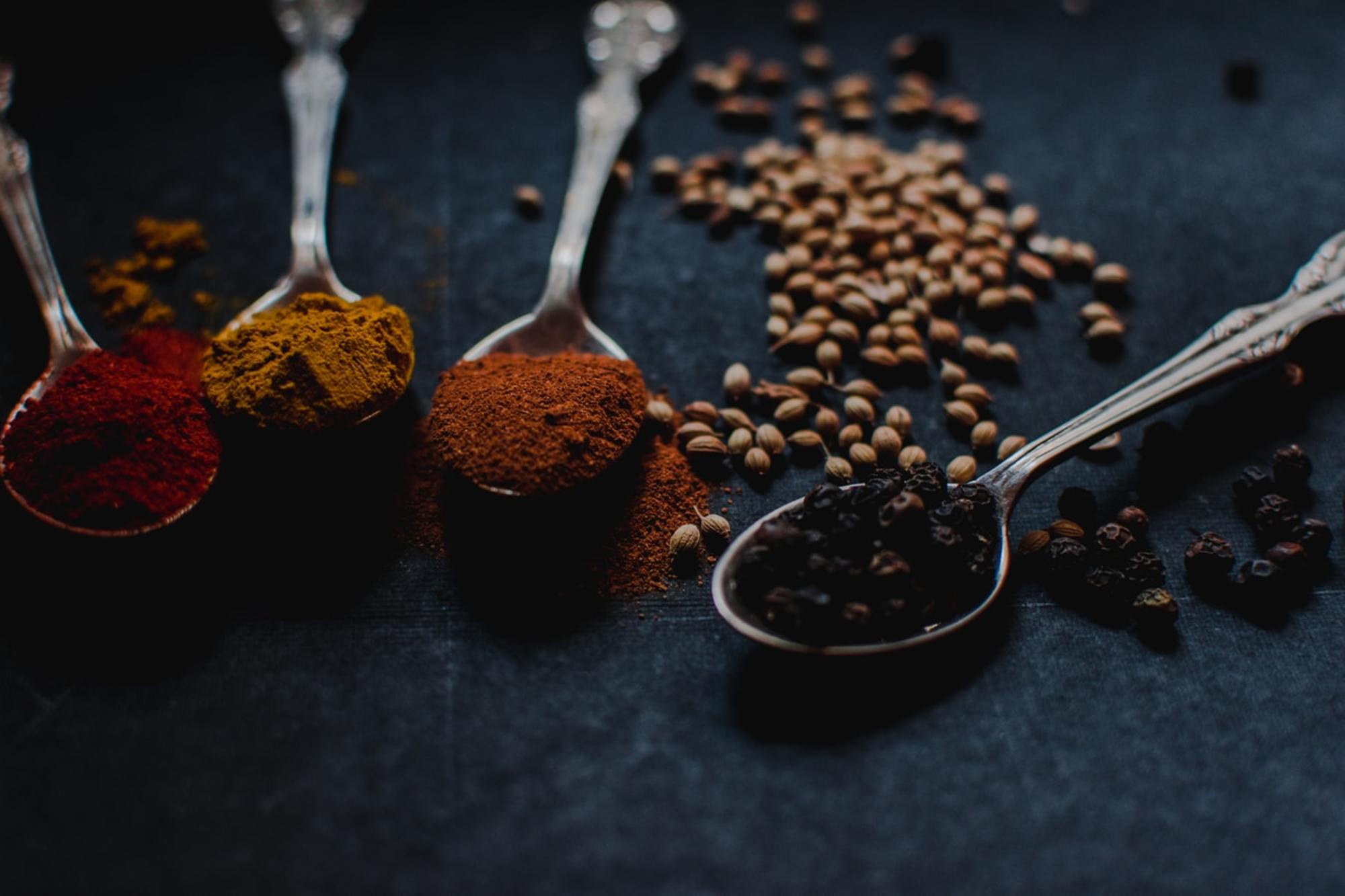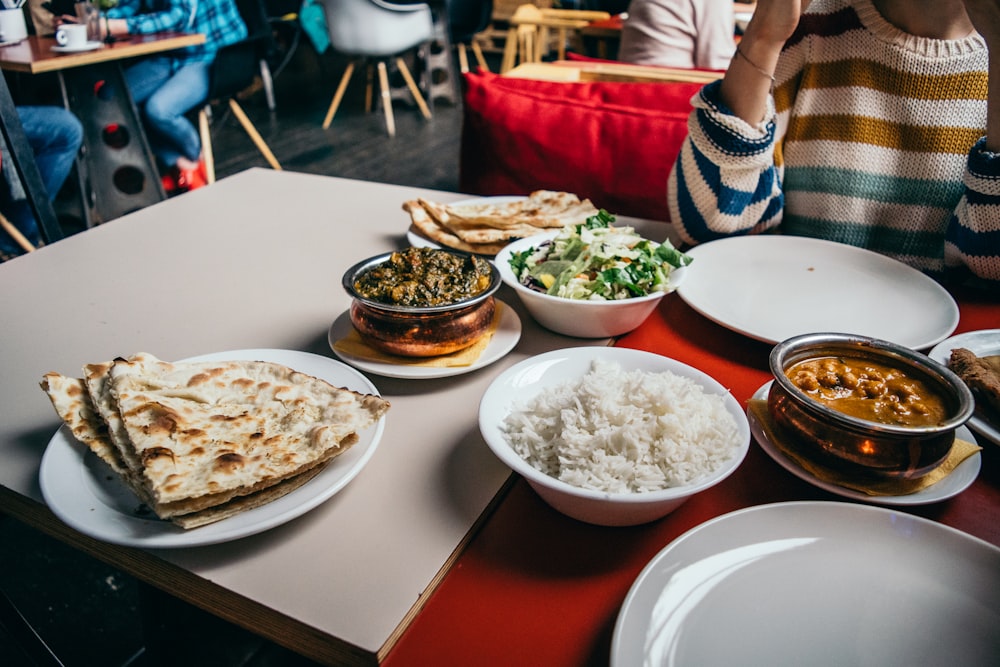
It depends on the geographical location (the proximity to the sea, mountains, or desert), economics, and season. The national foods have been heavily influenced by India’s religious beliefs, culture and traditions. Many historical events like a few centuries of Islamic rule, variety of trade relations, and colonialism have certainly played a major role in the evolution of the Indian cuisine. Vegetarianism is widely practiced in Buddhist, Hindu and Jain communities.
The authentic Indian cuisine features six main flavours: salty (lavana), sweet (madhura), pungent (katu), bitter (tikta), sour (amala), and astringent (kasya). India is called The Land of Spices for a reason. Curry, cardamom, ginger, cinnamon, mustard, garlic, cumin (zira), chilies, paprika, saffron, fenugreek, turmeric – all that and a lot of other seasonings are widely used in traditional foods. The most popular spice mix is garam masala. Every culinary region of the country has a distinctive garam masala blend. A variety of oils (vegetable, peanut, mustard, coconut, sesame, sunflower, safflower, cottonseed, and soybean) are the most often added to the dishes.
The basic cooking ingredients are pearl millet, rice, whole-wheat flour, and different lentils (masoor, urad, tuer, or moong). Some pulses like cholae, channa, rajma, and lobiya are commonly consumed in the northern regions of India. Beef these days is strictly forbidden within the territory of India (except in heavily Christianized Goa). Chicken and mutton are the most commonly used meats.
Geographical varieties
Northern Indian cuisine. The North Indian food is very similar to Pakistani cuisine as they share historic and cultural heritage. It is characterized by the high use of dairy products, such as milk, yoghurt, clarified butter, and paneer. Chilies, saffron and nuts are among the favored seasonings. Goat and lamb meats are the primary ingredients of many dishes. The staple food is different types of lentils, vegetables, and roti (wheat based bread).
The most popular dishes and drinks of Northern Indian cuisine are Tandoori chicken, Kebabs, Mirchi Vada (chili cutlet), Kachori (deep fried breads), Sharbat (cool fruit drink), Aam Panna (drink made of unripe green mangoes). Gulab Jamun (milk-solid-based sweet), Gajak (sweet dry snack) and some of the other sweets are most commonly consumed there.
Eastern Indian cuisine. Chinese and Mongolian cuisine has a strong influence on the Eastern Indian food. Traditional cuisine is not too spicy and faint. Because of climate, the staple grain in East India is rice. The usual meal consists of different side dishes made of vegetables. Fish is also frequently used in cooking, especially in Bengal. The basic ingredients of Eastern Indian cuisine are mustard seeds and paste, green and red chilies, Paanch Phoran (cumin, onion, mustard, fennel, and fenugreek seeds), coconut, maize and gram flour, yogurt, and dairy products.
The most popular dishes of Eastern Indian cuisine are Santula (vegetable dish), Sukto (vegetable medley), Thukpa (clear soup), Machcher Jhol (fish curry) etc. This region is well-known for the sweets like Sandesh (made of paneer and sugar), Rasgolla (dumplings in syrup), Kheer (creamy rice pudding) and many other.
Southern Indian cuisine. The cuisine of South India is characterized by the high use of rice, curry leaves coconut and coconut oil. Some meals include the biryani, seafood (mackerel, prawns, mussels etc.), and very thin pathiris (pancakes made of rice flour). Lentils, a lot of different spices, dried red chilies and fresh green chilies, native fruits and vegetables (tamarind, snake gourd, plantain, ginger, and garlic) are also the main ingredients of local food. Vegetarianism is widely practiced in the south of the country.
Among the most popular Southern Indian meals are Sambar (a vegetable stew), Rasam (tamarind juice or tomato soup), Hyderabadi biryani (chicken dish), Bonda (deep fried potato snack), Bajji (made by frying battered green chilies), Idli (savory, steamed saucer-like cake) and a lot of other dishes.
Western Indian cuisine. There are three major food groups in West India: Gujarati, Maharashtrian and Goan. Gujarati cuisine is mostly vegetarian. The main dishes are based on steamed vegetables, homemade pickles, rice or lentil, and buttermilk. The staple food of Maharashtrian cuisine is rice, coconut and fish. Hindu origins, Portuguese colonialism and modern techniques have an impact on the cuisine of Goa. The local meals are made of rice, a variety of fish (pomfret, shark, mackerel, tuna), and seafood (crabs, prawns, lobster, squid, and mussels).
The most known meals of West India are Bombay Duck, Vada Pav (spicy potato sandwiches between buns), Zunka Bhakri (bread made up of pearl millet flour), Goan Fish Curry (warm and tangy fish curry with coconut milk), Bebinca (pudding made of coconut milk), Shrikhand (sweet made of hung curd and yogurt) and Dhokla (made of rice and split chickpeas).
Look also to the absolutely different cuisine of Austria!

